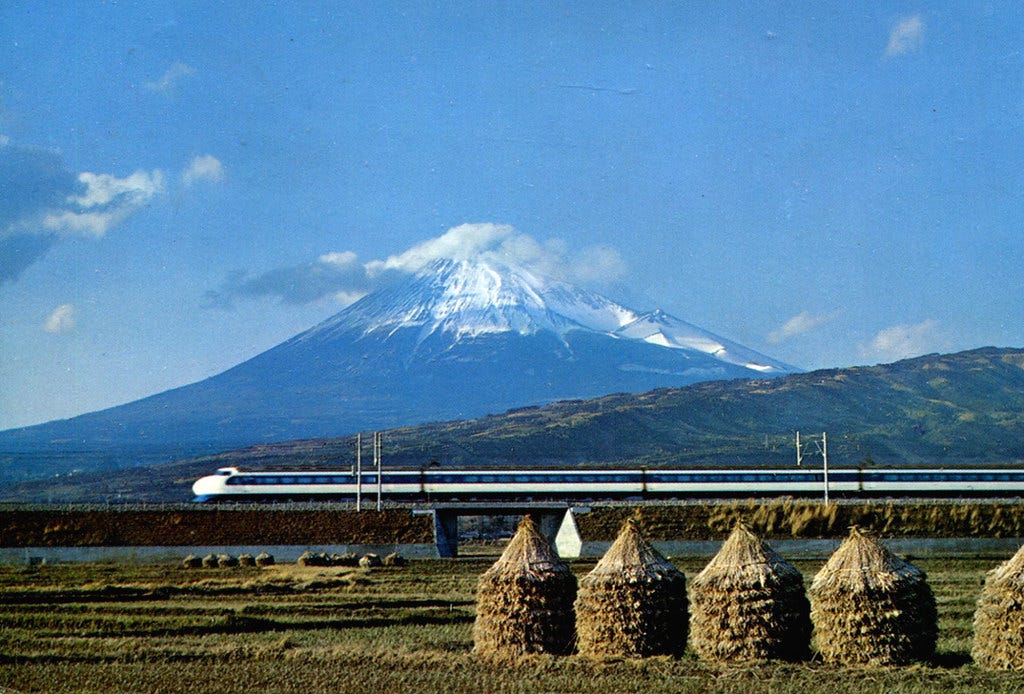The Cascadia Bullet Train: Build it Because They're Coming
If zoomers, climate refugees, and adventure seekers are moving to the Pacific Northwest (and they are), then we need a better way of moving us all around.
Editor’s Note: Do your part to Sustain the Way!
18 Oregonians have gotten us to $980 - keep the momentum going so we can hire a part time editor.
Will you send $20?
Donate here or subscribe below to create a part-time editor position. Thank you! - kevin
Kevin Frazier edits The Oregon Way between Zoom classes at the UC Berkeley School of Law. He’s a proud Duck (Class of ‘15) and former state government employee.

Imagine getting from Portland to Seattle in under an hour…in a bullet train…zooming passed the Cascades at about 250 miles per hour.
Sounds impossible, right? Wrong.
In fact, a feasibility study of the so-called Cascadia bullet train suggests that this infrastructure project could incite job creation in the short and long term, reduce emissions, and ease pressure on the rest of our transportation network. More specifically, the Washington State Department of Transportation “estimated $355 billion in economic growth and 200,000 new jobs related to construction and ongoing operation” from the project.
Admittedly, my relationship with the idea of a bullet train spanning the northern part of the I-5 corridor has waxed and waned more frequently than the moon. A trip across Switzerland via the Glacier Express introduced me to what a functioning public train system can look like—and started my fraught relationship with bullet train proposals in the US.
It was impossible not to leave Switzerland as a train advocate. Face-pressed to the window of the Express, I could not believe how much of the Swiss landscape I was able to see from the comfort of a clean and comfortable train cabin. When I stopped looking at the glaciers and villages whizzing by, I was able to do work via in-train wifi—sustaining myself with fresh food and warm cocoa. When I missed a train, there was another coming within an hour. When I changed plans and wanted to see a new site, there was a train that’d get me there or at least nearby.

My advocacy hit a wall when I moved to California. As a resident of the Golden State, I watched then-Governor Jerry Brown tout a “bullet train” connecting LA and San Francisco. Years and tens of billions of dollars later, there’s no such connection nor will there ever be.
What once was a project meant to transform the state has turned into a slow train1 to nowhere.2 Californians deserve better. The project has sucked up resources, expertise, and, for many bullet train advocates, hope.
Why, then, should we push for a bullet train in the Northwest?
First, there’s support from public and private stakeholders. At the federal level, the Biden Administration has made clear that a massive infrastructure package will be one of his main priorities.
At the state/province level, leaders of each jurisdiction have been receptive to the idea. The Premier of British Columbia John Horgan signaled support for the project—stating that "[i]mproving connectivity in the Pacific Northwest region through ultra high-speed rail presents enormous potential for job and economic growth on both sides of the border." Washington Governor Jay Inslee echoed those sentiments—asking us all to "[i]magine fast, frequent, and reliable travel with the potential for zero emissions and the opportunity to better compete in a global economy." Our own Governor Brown pointed out that "[t]his type of bold investment would help position our region for the future."
Private sector stakeholders also celebrate the returns on this bold investment. Microsoft President Brad Smith, for instance, remarked that “[h]igh-speed rail will shrink travel times throughout the Cascadia Corridor, providing a strong transportation core for our region.”
Second, now’s the time for massive investment. From stimulus checks to bullet trains, injecting our economy with funds and projects is Recovery 101. An investment on the scale of a region-wide bullet train would transform lives and communities by creating initial jobs to complete the train and indirect employment in the long term due to greater tourism and commerce.
Third, the pandemic has made the idea of region-wide planning more important. As more and more people are freed from the daily office grind and permitted to find a home anywhere in the world, so-called “Zoomers” will go where there’s innovation, plenty of adventure, and good transportation. The Northwest has the first two locked down. A bullet train could allow us to reach the third.
Finally, if Zoomers weren’t already flocking to our corner of the country, climate change will soon send even more people in our direction. According to some estimates, rising seas could displace as many as 13 million Americans by 2100. The Pacific Northwest will be an attractive destination for Americans and others looking to escape the worse effects of climate change. Our current transportation infrastructure is not capable of meeting the demands of these new residents. We have to plan ahead.
Don’t get me wrong, I’m still scarred from the Columbia River Crossing and a whole slew of seemingly straightforward infrastructure projects that have spent more on consultants than concrete.
But, perhaps what we need is a Pacific Northwest moonshot—a bullet train that would transform a region, our economy, and our culture—to get shovels in the ground and to put plans into action.

An inability to get the necessary land rights will force the train to go around too many curves to reach bullet speeds.



